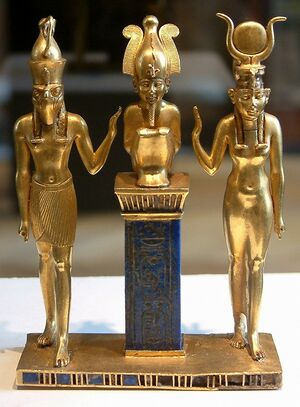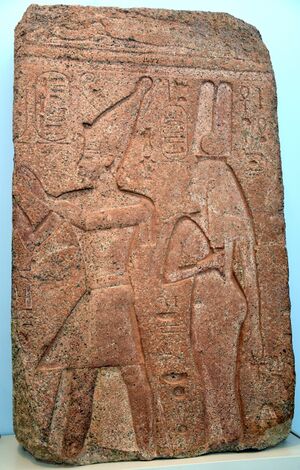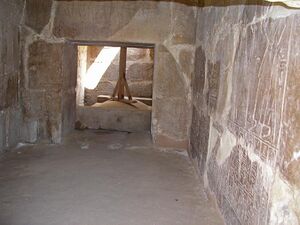اوسركون الثاني
| اوسركون الثاني | ||||||||||||||||||||||||||||||||||||||||||||||||||||||||||||
|---|---|---|---|---|---|---|---|---|---|---|---|---|---|---|---|---|---|---|---|---|---|---|---|---|---|---|---|---|---|---|---|---|---|---|---|---|---|---|---|---|---|---|---|---|---|---|---|---|---|---|---|---|---|---|---|---|---|---|---|---|
 قلادة تحمل خرطوش اوسركون الثاني | ||||||||||||||||||||||||||||||||||||||||||||||||||||||||||||
| فرعون مصر | ||||||||||||||||||||||||||||||||||||||||||||||||||||||||||||
| الحكم | 872–837 ق.م., الأسرة الثانية والعشرون | |||||||||||||||||||||||||||||||||||||||||||||||||||||||||||
| سبقه | تكلوت الأول | |||||||||||||||||||||||||||||||||||||||||||||||||||||||||||
| تبعه | شوشنق الثالث | |||||||||||||||||||||||||||||||||||||||||||||||||||||||||||
| ||||||||||||||||||||||||||||||||||||||||||||||||||||||||||||
| القرينة | كاروماما الأولى | |||||||||||||||||||||||||||||||||||||||||||||||||||||||||||
| الأنجال | تجسباستپرو، نملوت ج، شوشنق د، حورنخت | |||||||||||||||||||||||||||||||||||||||||||||||||||||||||||
| الأب | تكلوت الأول | |||||||||||||||||||||||||||||||||||||||||||||||||||||||||||
| الأم | كاپس | |||||||||||||||||||||||||||||||||||||||||||||||||||||||||||
| توفي | 837 ق.م. | |||||||||||||||||||||||||||||||||||||||||||||||||||||||||||
| المدفن | NRT-I، تانيس | |||||||||||||||||||||||||||||||||||||||||||||||||||||||||||
أوسرماعترع ستپإنآمون اوسركون الثاني، هو خامس ملوك[1] الأسرة الثانية والعشرين في مصر القديمة، وابن الملك تكلوت الأول والملكة كاپس. حكم مصر من حوالي عام 872 ق.م. حتى 837 ق.م. من تانيس، عاصمة الأسرة. بعد خلافته والده، واجه الحكم المنافس لابن عمه، الملك حرسيسي آ، الذي سيطر على كل من طيبة وواحة مصر الغربية. خشي اوسركون من التحدي الخطير الذي يمثله حكم حرسيسي لسلطته، لكن عندما توفي حرسيسي عام 860 ق.م.، ضمن اوسركون الثاني أن هذه المشكلة لن تتكرر من خلال تعيين ابنه نملوت ج في منصب كبير كهنة آمون في طيبة. أصبح ابنه الأصغر شوشنق كبير كهنة پتاح في منف. في هذه الفترة من تاريخ مصر، كانت السلطة الدينية والسياسية لا يمكن فصلهما على الإطلاق.
سياسته الخارجية والبرنامج الأثري
وعلى الرغم من براعته في التعامل مع الأمور الداخلية، اضطر اوسركون إلى أن يكون أكثر عدوانية على الساحة الدولية. إن القوة المتنامية لآشور تعني زيادة تدخل الأخيرة في شؤون إسرائيل وسوريا - وهي مناطق تقع ضمن النفوذ المصري. عام 853 ق.م.، قاتلت قوات اوسركون، في تحالف مع قوات إسرائيل وجبيل، جيش شلمنصر الثالث في معركة قرقر مما أدى إلى توقف التوسع الآشوري في كنعان، لفترة وجيزة.
نجد في تل بسطة باباً ضخماً منحوتاً من الجرانيت يخلد الإحتفال باليوبيل الملكي لهذا الملك، وفي تانيس وتل بسطة كذلك عثر على عدد من الأعمدة النخيلية الدقيقة الصنع التي اقتلعت من مدينة بي رعمسيس وامتلأت باسمه، والتي تبين كذلك تنحية الإله ست وتحريم عبادته، وأيضا النقوش الجميلة المنحوتة على جدران المقبرة التي أعاد تجهيزها لنفسه في تانيس، والمدفن الذي بناه في مدينة منف لابنه الأكبر الذي كان كبيراً لكهنة پتاح. ومن تذكارات سكرتيره الخاص المدعو "حورمس"، ومن القطع الجنائزية للأمير حورنخت كبير كبير آمون الذي دفن في تانيس تشكلت باقة منتقاة من الفنون التطبيقية الرائعة. شيد اوسركون الثاني مقصورة في طيبة عهد بإدارتها لأحد أبنائه الآخرين هو نملوت كبير كهنة آمون. كما كلف حفيده نائب الملك في كوش بإصلاح وترميم المعبد الرئيسي في إلفنتين.[2]
مدة حكمه
حوالي عام 837 ق.م، توفي أوسركون الثاني ودُفن في المقبرة NRT I في تانيس. يُعتقد حاليًا أنه حكم لأكثر من 30 عامًا، وليس 25 عامًا فقط كما تم تفسيره سابقًا. كان يُعتقد أن الملك احتفل بأول يوبيل سـِد في عامه 22، لكن تـريخ حـِب-سـِد في معبده الكبير في بوباستس تالف ويمكن قراءته أيضًا على أنه العام 30، بحسب ما يشير إدوارد ونت.[3] حقيقة أن حفيد هذا الملك، تكلوت ح، خدم كبير كهنة آمون في طيبة-كما تثبت جدران المعبد ج المنقوشة- تعم فرضية فترة حكم أطول لاوسركون الثاني.
لقد ثبت مؤخرًا أن نص منسوب النيل 14 (المؤرخ بالسنة 29 من حكم أوسرماعترع ستپإنآمون) ينتمي إلى اوسركون الثاني على أسس پاليوگرافية.[4] تشير هذه النتيجة إلى أن اوسركون الثاني على الأرجح احتفل بأول حـِب-سـِد في عامه الثلاثين كما كان الحال تقليديًا مع ملوك العصر الليبية، مثل شوشنق الثالث وشوشنق الخامس. بالإضافة إلى ذلك، لا يحتوي نصب العام 22 من حكمه على أي ذكر لأي احتفالات بحـِب-سـِد في تلك السنة، كما هو متوقع.
في حين أن طول مدة حكم اوسركون الثاني الدقيق غير معروف، فإن بعض علماء المصريات، مثل يورگن فون بِكِرات - في كتابه لعام 1997 التسلسل الزمني للفراعنة المصريين[5]- واقتراح أيدان دودسون فترة حكم تتراوح بين 38 و39 عامًا.[6] ومع ذلك، لم يتم التحقق من هذه الأرقام الأعلى بكثير من خلال الأدلة الضخمة الحالية. يقدر جرارد بروكمان حكم اوسركون الثاني بمدة أقصر قليلاً تبلغ 34 عامًا.[7] عالم المصريات الإنگليزي كنيث كتشن، في مقال بعنوان "مصر والشام" نُشرت عام 2006، يقبل الآن أنه إذا تم نسب نص منسوب النيل 14 بشكل صحيح إلى العام 29 من حكم اوسركون الثاني، فيجب تعديل الإشارة إلى يوبيل مهرجان سـِد لاوسركون من العام 22 إلى العام 30.[8] يقترح كتشن أن اوسركون الثاني توفى بعد ذلك بوقت قصير، في عامه الحادي والثلاثين.[9]
الزواج والأنجال
يُعرف أن اوسركون الثاني كان لديه أربعة زوجات على الأقل:
- الملكة كاروماما، من أشهر زوجات اوسركون. كانت كاروماما أمًا لولدين وثلاث بنات على الأقل:[10][11]
- إستإمخب، هي المعروف أنها والدة لابنة اسمها تجسباستپرو، والتي كانت متزوجة من كبيير كهنة پتاح تكلوت ب.[10] دجدموتإساخ الرابعة
- دجدموتإساخ الرابعة، هي والدة كبير كهنة آمون نملوت ج.[10] بدوره، كان نملوت ج والداً لتكلوت ح، الذي حكم لاحقاً باسم تكلوت الثاني.
- موتماحت إحدى زوجات اوسركون الثاني.
ومن أنجال اوسركون المسجلين الآخرين:
- الأمير شوشنق د، وكان كبير كهنة پتاح.
- الأمير حورنخت، وكان كبير كهنة آمون في تانيس.[12] عينه والده اوسركون الثاني كبيراً لكهنة آمون في تانيس لتعزيز سلطته في مصر السفلى؛ ومع ذلك، كان من الواضح أن هذه كانت خطوة سياسية حيث توفي حررنخت قبل أن يبلغ العاشرة من عمره.[13]
- الأميرة تاشاخپر، ربما كانت زوجة الآلهة آمون في عهد تكلوت الثالث.
- الأميرة كاروماما ج، من المحتمل أنها هي نفسها كاروماما مريموت، زوجة الإله آمون.
- الأميرة تاعيمـِر
من بين الأنجال المحتملين الآخرين المنسوبين إلى اوسركون الثاني خليفته شوشنق الثالث وابنة الملك تنتسـِپـِح (د)، زوجة القائد پتاحأودجانخـِف، ابن نملوت ج، وبالتالي حفيد اوسركون الثاني.[10]
خليفته
جادل ديڤد أستون بشكل مقنع في الورقة JEA 75 بأن اوسركون الثاني خلفه شوشنق الثالث في تانيس وليس تكلوت الثاني سي-إيسي كما افترض كتشن لأنه لم يتم العثور على أي من آثار تكلوت الثاني في مصر السفلى حيث ذُكر ملوك تانيسيين حقيقيين آخرين مثل اوسركون الثاني وشوشنق الثالث وحتى پامي الذين لم يعمروا طويلاً (6-7 سنوات) على لوحات التبرع وجدران المعبد و/أو الوثائق السنوية.[14] الوثائق الوحيدة التي تذكر الملك تكلوت هنا مثل المقبرة الملكية في تانيس، لوحة تبرع للعام التاسع من بوباستس وجعران على شكل قلب يحمل اسم "تاكلوت مريآمون" - تُنسب الآن حصريًا إلى الملك تكلوت الأول. لاحظ عالم المصريات الإنگليزي إيدان دودسون في كتابه الصادر عام 1994 بعنوان "المقتنيات الكانوپية لملوك مصر"، أن شوشنق الثالث بنى "جدارًا فاصلًا، بمشهد مزدوج يظهر اوسركون الثاني" ونفسه "كل منهما يعبد إلهًا لم يذكر اسمه" في ردهة مقبرة اوسركون الثاني.[15] ويخلص دودسون إلى أنه في حين يمكن للمرء أن يجادل بأن شوشنق الثالث أقام الجدار لإخفاء تابوت اوسركون الثاني، فإنه لم يكن من المنطقي أن يقوم شوشنق بإنشاء مثل هذا النقش المتقن إذا كان تكلوت الثاني قد حكم بالفعل بينه وبين اوسركون الثاني في تانيس لمدة 25 عامًا، هذا ما لم يكن شوشنق الثالث الخليفة المباشر لاوسركون الثاني. ومن ثم، لا بد أن شوشنق الثالث كان يرغب في الارتباط بسلفه - اوسركون الثاني.[16] وبالتالي، فإن قضية تنصيب تكلوت الثاني كملك للأسرة الثانية والعشرين وخليفة لاوسركون الثاني، تختفي، كما يشير دودسون. كما أيد علماء آخرون مثل جرارد بروكمان وكارل يانسن ڤينكلن بقوة هذا الموقف. كتب جرارد بروكمان في مقال نشر في GM عام 2005 أنه "في ضوء الأدلة الأثرية وعلم الأنساب"، فإن التسلسل الزمني لأستون لترتيب ملوك الأسرة الثانية والعشرين "يفضل بشدة" على التسلسل الزمني الذي وضعه كتشن.[17]
مقبرته
في 27 فبراير 1939 اكتشف عالم المصريات الفرنسي پيير مونتيه مقبرة اوسركون الثاني الملكية المنهوبة بالكامل في تانيس. وكشفت أن اوسركون الثاني دفن في تابوت ضخم من الجرانيت بغطاء منحوت من تمثال من عصر الرعامسة. لم يتبق في المقبرة المسروقة سوى بعض أجزاء من تابوت على شكل رأس صقر وجرار كانوپية للتعرف عليه.[18] على الرغم من أن المقبرة قد نُهبت في العصور القديمة، إلا أن المجوهرات المتبقية "كانت ذات جودة عالية لدرجة أنه كان لا بد من مراجعة المفاهيم الحالية لثروة الأسرتين الشماليتين الحادية والعشرين والثانية والعشرين".[19]
المصادر
- ^ Osorkon (II) Usermaatre, Digital Egypt for Universities.
- ^ پاسكال ڤيرنوس (1999). موسوعة الفراعنة. دار الفكر.
{{cite book}}: Unknown parameter|coauthors=ignored (|author=suggested) (help) - ^ Edward Wente, Review of Kenneth Kitchen's The Third Intermediate Period in Egypt c.1100-650 BC, JNES 35(1976), pp.275-278
- ^ Gerard Broekman, "The Nile Level Records of the Twenty-Second and Twenty-Third Dynasties in Karnak," JEA 88(2002), pp.174-178
- ^ Jürgen von Beckerath, Chronologie des Pharaonischen Ägypten, MAS:Philipp von Zabern, (1997), p.98 & p.191
- ^ Aidan Dodson, A new King Shoshenq confirmed?, GM 137(1993), p.58
- ^ Gerard Broekman, 'The Reign of Takeloth II, a Controversial Matter,' GM 205(2005), pp.31 & 33
- ^ Kenneth Kitchen, Agypten und Levante 16 (2006), p.299 point No.7
- ^ Kitchen, Agypten und Levante 16 (200), p.301 section 16
- ^ أ ب ت ث Aidan Dodson & Dyan Hilton: The Complete Royal Families of Ancient Egypt. Thames & Hudson, 2004, ISBN 0-500-05128-3
- ^ Kitchen, The Third Intermediate Period in Egypt (1100–650 BC). 3rd ed. Warminster: Aris & Phillips Limited. 1996
- ^ .Nos ancêtres de l'Antiquité, 1991. Christian Settipani, p.153 and 166
- ^ Nicolas Grimal, A History of Ancient Egypt, Blackwell Books, 1992. p.325
- ^ Aston, op. cit., pp.139-153
- ^ Aidan Dodson, "The Canopic Equipment of the Kings of Egypt," (Kegan Paul Intl: 1994), p.95
- ^ Dodson, op. cit., p.95
- ^ Gerard Broekman, 'The Reign of Takeloth II, a Controversial Matter,' GM 205(2005), pp.31
- ^ "San el-Hagar". Archived from the original on 2009-01-20. Retrieved 2006-02-18.
- ^ Bob Brier, Egyptian Mummies: Unravelling the Secrets of an Ancient Art, William Morrow & Company Inc., New York, 1994. p.144





